
Prasophyllum alpinum, commonly known as the alpine leek orchid, is a species of orchid endemic to Tasmania. It was formerly described as occurring in mainland Australia but has smaller flowers than the species occurring there. It has a single, tube-shaped leaf and up to fourteen green to greenish-brown flowers and grows in subalpine areas.

Prasophyllum alpestre, commonly known as the mauve leek orchid, is a species of orchid endemic to eastern Australia. It has a single tubular, green leaf and up to twenty five scented, white, purplish and green flowers. It grows in subalpine parts of New South Wales, Victoria and Tasmania.

Prasophyllum petilum, commonly known as the Tarengo leek orchid, is a species of orchid endemic to eastern Australia. It has a single tubular, green leaf and up to eighteen pinkish mauve to greenish flowers, well-spaced along a slender flowering stem. It is a small orchid, difficult to locate, generally growing in taller grasses.
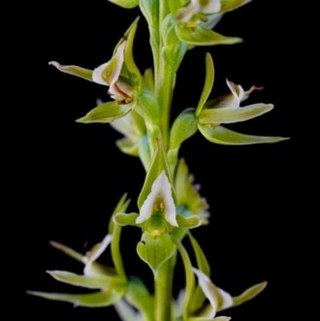
Prasophyllum montanum, commonly known as the mountain leek orchid, is a species of orchid endemic to eastern Australia. It has a single tubular, green leaf and up to fifty scented, greenish to pinkish flowers. It grows in montane ecosystems at altitudes above 1,500 m (5,000 ft).
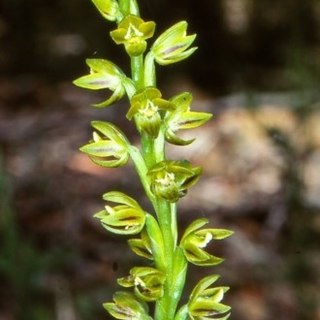
Prasophyllum flavum, commonly known as the yellow leek orchid, is a species of orchid endemic to eastern Australia. It has a single tubular, green leaf with only a short free section and up to fifty scented, yellowish-green flowers.
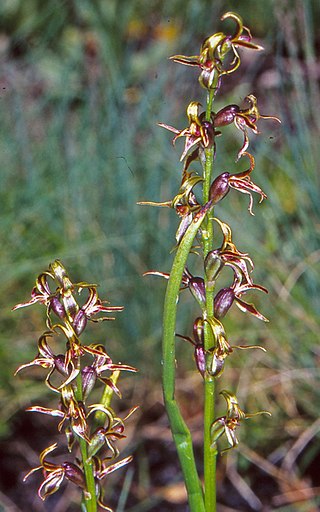
Prasophyllum sphacelatum, commonly known as the subalpine leek orchid, is a species of orchid endemic to south-eastern Australia. It has a single tubular, dull green leaf and up to eighteen scented, green to brownish flowers with a green to pinkish labellum. It grows in subalpine areas of New South Wales, Victoria and Tasmania.
Prasophyllum bagoense, commonly known as the Bago leek orchid, is a species of orchid endemic to a small area of southern New South Wales. It has a single tubular, green leaf and up to thirty scented, pale tawny green flowers on a flowering stem. It grows in subalpine grassland in a single population near Tumbarumba.

Prasophyllum wilkinsoniorum is a species of orchid endemic to New South Wales. It has a single tubular, bright green leaf and up to forty five scented, dark greenish-brown to brownish-red flowers with a green to pinkish labellum. It grows in grassy places in a restricted area on the Southern Tablelands.
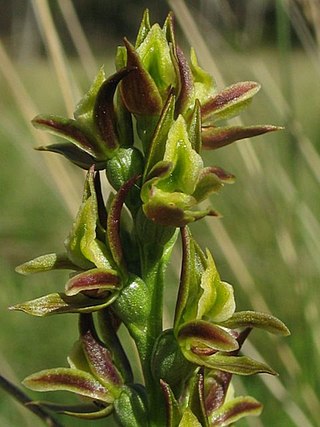
Prasophyllum canaliculatum, commonly known as the channelled leek orchid or summer leek orchid, is a species of orchid endemic to a small area of southern New South Wales. It has a single tubular, bright green leaf and up to twenty five scented, greenish-red or brownish flowers on a flowering stem. It grows in woodland at altitudes around 1,000 m (3,000 ft) where only about two hundred plants survive.
Prasophyllum candidum, commonly known as the Kiandra leek orchid, is a species of orchid endemic to eastern Australia. It has a single tubular, yellowish-green leaf and up to forty scented, bright white to greenish flowers. It grows in subalpine areas at altitudes above 1,000 m (3,000 ft) in New South Wales and Victoria although in the latter state it is considered to be a form of P. odoratum.

Prasophyllum caudiculum, commonly known as the Guyra leek orchid, is a species of orchid endemic to a small area of northern New South Wales. It has a single tubular, bright green leaf and up to thirty five greenish to reddish-brown flowers crowded along an erect flowering stem. It grows in grassy places near Guyra.
Prasophyllum brevilabre, commonly known as the Gorae leek orchid, is a species of orchid endemic to south-western Victoria. It has a single tubular, green leaf and up to forty greenish-brown flowers with reddish markings. It is a very rare orchid, now only known from two small, scattered populations. It was first recorded from Gorae West near Portland but is no longer found there.

Prasophyllum dossenum is a species of orchid endemic to a small area of northern New South Wales. It has a single tubular, dark green leaf and up to thirty scented pinkish-white and greenish-brown flowers crowded along an erect flowering stem. It is a rare orchid which grows in grassy places on the Northern Tablelands of New South Wales.
Prasophyllum hygrophilum, commonly known as the swamp leek orchid, is a species of orchid endemic to Victoria. It has a single tubular green leaf and up to thirty greenish brown, pink or mauve flowers. It is a rare orchid only known from two populations and is classified as "endangered" in Victoria.
Prasophyllum litorale, commonly known as the coastal leek orchid, is a species of orchid endemic to southern continental Australia. It has a single tubular leaf and up to forty flowers with red and green colouring and grows in sandhills near the sea.

Prasophyllum morganii, commonly known as the Cobungra leek orchid, is a species of orchid endemic to a small area in Victoria. It has a single tubular leaf and up to eighty greenish flowers with purplish markings. Before being rediscovered in 2020, the plant had last been seen in 1933 and was presumed extinct.

Prasophyllum solstitium is a species of orchid endemic to the Northern Tablelands of New South Wales. It has a single tubular, bright green leaf and up to thirty five greenish-pink to purplish-red flowers crowded on the flowering stem. It grows in grassland on heavy basalt soil.
Prasophyllum rogersii, commonly known as the Barrington Tops leek orchid is a species of orchid endemic to New South Wales. It has a single tubular leaf and up to twenty five reddish-brown flowers and only occurs in a few locations at higher altitudes.
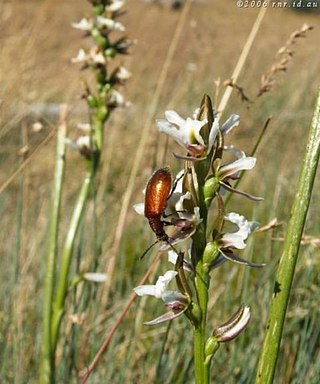
Prasophyllum suttonii, commonly known as the mauve leek orchid, Mount Buffalo leek orchid or Buffalo leek-orchid, is a species of orchid endemic to the Australian Alps. Some authorities list the species as being a Victorian endemic now extinct whilst others list is as occurring in New South Wales and extant. Descriptions of the species also differ. It has a single tube-shaped leaf and up to thirty five white flowers with purple or mauve marks.

Prasophyllum viretrum is a species of orchid endemic to Victoria. It has a single tubular, dark green leaf and up to thirty five scented, greenish-brown to brownish flowers and is only known from a few small populations in south-western Victoria.













